EQカーブの歴史、ディスク録音の歴史を(私が独りで勝手に)学ぶ本シリーズ。前回 Pt.22 では、1950年代以降の 民生用アンプに内蔵されたフォノイコの変遷 について学びました。
On the previous Part 22, I learned the historys — especially the transition of the built-in phono equalizers — in the late-1950s to mid-1960s.
今回の Pt.23 では、1970年代民生用アンプに内蔵されたフォノイコの RIAA 偏差 に関する興味深い記事、および、米国で伝統的に使われていた LCR 録音イコライザ の話などをみていきます。
This time on Pt.23, I am going to learn the interesting article on RIAA deviations of 1970s’ consumer amplifiers, as well as LCR recording equalizers that had been the legacy especially in the United States.
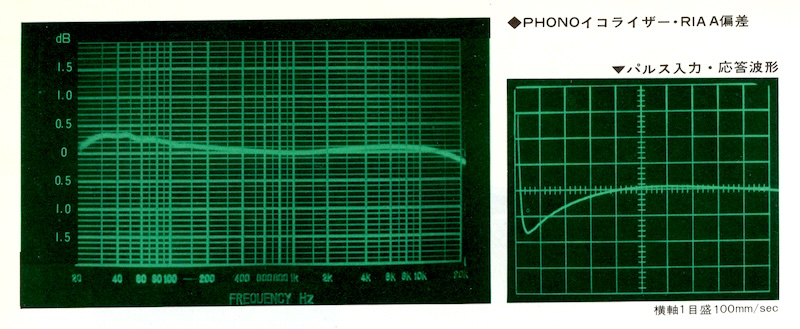
source: 季刊ステレオサウンド No.21 ’72 (Vo. 7, No. 2) 特別増刊 プリアンプ・パワーアンプのすべて (1972)
SONY TA-2000F プリアンプ内蔵フォノイコの RIAA 偏差とパルス応答特性
RIAA deviation and pulse response of SONY TA-2000F’s phono preamp
毎回書いている通り、筆者自身の学習過程を記したものですので、間違いの指摘や異論は遠慮なくお寄せください。
As I noted in every part of my article, this is a series of the footsteps of my own learning process, so please let me know if you find any mistakes on my article(s) / if you have different opinions.
いつものように長くなってしまいましたので、さきに要約を掲載します。同じ内容は最後の まとめ にも掲載しています。
Again, this article become very lengthy — so here is the summary of this article beforehand (the same summary are avilable also in the the summary subsection).
1972年に発行された日本のオーディオ雑誌の特集に、当時の国内外のプリアンプの内蔵フォノイコライザ全21機種の特性計測結果が掲載されているが、各メーカ、各機種ごとに RIAA 偏差のばらつきが非常に大きく、全て RIAA 準拠と謳ってはいるものの、その実装方法や補正特性がバラバラであったことを確認した。
In a Japanese audio magazine published in 1972, there was a special feature on 21 preamplifiers available at that time, in which the characteristic measurement results of the built-in phono EQs of each model were published. Although all of them claim to be RIAA-compliant, I confirmed that their implementations and compensation characteristics were so different each other.
放送局など米国プロフェッショナル機器においては、伝統的にベル研やWestrexのレガシーの享受を受けてきたが、この際、ディスク録音イコライザ(やプロフェッショナル用再生イコライザ)はLCR回路で構成されていた。一方、民生用のオーディオ装置においては、インダクタに伴うコストの問題や品質の均一性の問題から、RC回路によるフォノイコがほとんどである。
In U.S. professional field, such as broadcasting stations, they had traditionally enjoyed the legacy of Bell Labs and Westrex, in which disc recording equalizers (and professional playback equalizers) were constructed with LCR circuits. On the other hand, in the consumer audio market, most amplifiers had built-in phono EQs with RC circuits, highly presumably due to cost issues associated with inductors and quality uniformity.
1920年代〜の歴史的録音・映像の復刻や、当時の録音再生機器のプロフェッショナルである Nicholas Bergh 氏は、現代の「アーカイブ用可変フォノイコライザ」はRC型であり、レコードが録音された当時のLCR型録音イコライザとは厳密に対応できない点を、学会発表で指摘している。
Nicholas Bergh, a professional in the reissue of historical recordings and videos from the 1960s onward, and a professional in the field of recording/reproducing equipment of the time, pointed out in his conference presentation that, modern “archival” variable phono EQs are of the RC type, and do not exactly correspond to the LCR type recording equalizers of the time the records were made.
Contents / 目次
23.1 Deviation from the ideal RIAA reproducing characteristic
前回 Pt. 22 では、当時の民生用オーディオコンポーネントのスペックを追いましたが、この後もますますソリッドステート率があがり、非 RIAA 対応内蔵フォノEQ が減る一方なのは自明でしょう。
In the previous Pt. 22, we have followed the history of the specifications of consumer audio components of the time. It is obvious that the percentage of solid-state components will continue to increase, and the number of non-RIAA built-in phono EQs will continue to decrease.
さて次は、2024年4月に X (was: Twitter) 上で onojii さんに教えてもらった興味深い情報を紹介します。アンプに内蔵されたフォノEQ回路のRIAA 偏差という観点です。
Well, let me continue this Pt.22 article with yet another interesting information that was shared with me by onojii-san on X (was: Twitter) in April 2024. It is in terms of the RIAA deviation of the phono EQ circuit builts into the amplifiers.
これは1971年にステレオサウンド誌が測定した内外のプリアンプのRIAA偏差実測値。基準にした「正しい」カーブの詳細は調べきれませんでしたが、相対としてこれだけの違いがあるわけで、極論すれば録音制作側も再生側も、RIAAカーブ「みたいな」特性で聴いていたと言いたくもなります。(続く) pic.twitter.com/AtXFlElVw1
— onojii (@onojii1020) April 19, 2024
これは、1972年1月に発行された、季刊ステレオサウンド特別増刊(No.21 ’72)「プリアンプ・パワーアンプのすべて」に掲載されたものです。古書店で入手しました。
This was published in the Jan. 1972 special issue of “Stereo Sound” (quarterly audio magazine in Japan), entitled “All About Preamplifiers and Power Amplifiers”. I obtained this opy from an antiquarian bookstore.
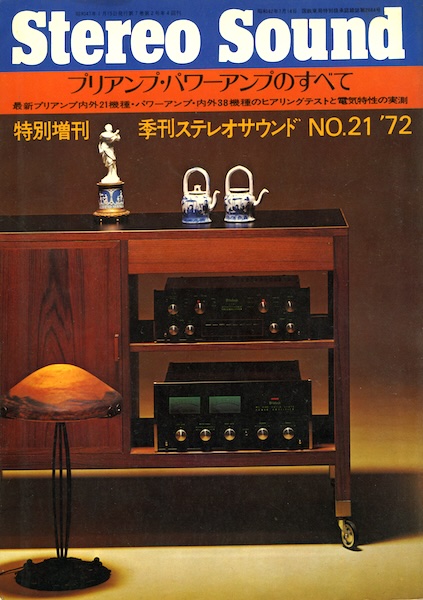
季刊ステレオサウンド No.21 ’72 (Vo. 7, No. 2) 特別増刊 プリアンプ・パワーアンプのすべて (1972)
このムックでは、1971年暮れ当時に日本で販売されていた、国内外の最新プリアンプ21機種とパワーアンプ38機種が特集されているのですが、非常に興味深いことに、各プリアンプに内蔵されたフォノイコライザの RIAA 偏差 の計測結果グラフが掲載されているのです。
This magazine features 21 of the latest preamplifiers and 38 of the latest power amplifiers that were sold in Japan at the end of 1971, and very interestingly, it includes a graph showing the measured RIAA deviation of each preamplifier’s built-in phono equalizer.
プリアンプ/パワーアンプの性能計測は、長島達夫氏によって行われました。RIAA 偏差計測では、長島氏自作の逆RIAAフィルタ(最大偏差±0.1dB以内)と、目黒電波測器製のスイープジェネレータとスペアナを使った測定で、全体でも最大偏差±0.2dB以内での計測結果が掲載されています。
Performance measurements of these preamplifiers and power amplifiers were conducted by Mr. Tatsuo Nagashima, using an inverse RIAA filter of his own design (within ±0.1dB of maximum deviation), and a sweep generator and a specttrum analizer, both manufactured by Meguro Electronics Corporation — with overall measurements within ±0.2dB of maximum deviation.
RIAA 偏差のような静的特性だけではなく、クリップレベルでの 1kHz / 10kHz 信号入力時のフォノEQ通過後の出力波形と歪波形も掲載されており、さらにはフォノEQのパルス応答特性のような時間軸での動的特性もしっかり計測されています。
Not only static characteristics such as RIAA deviation, bu also output waveforms and distortion waveforms after passing through the phono EQ at 1kHz / 10kHz signal input at the clipping level are included. Also, dynamic characteristics on the time axis such as pulse response characteristics of the phono EQs are also well measured.

source: 季刊ステレオサウンド No.21 ’72 (Vo. 7, No. 2) 特別増刊 プリアンプ・パワーアンプのすべて (1972)
SONY TA-2000F プリアンプ内蔵フォノイコの RIAA 偏差とパルス応答特性
RIAA deviation and pulse response of SONY TA-2000F’s phono preamp
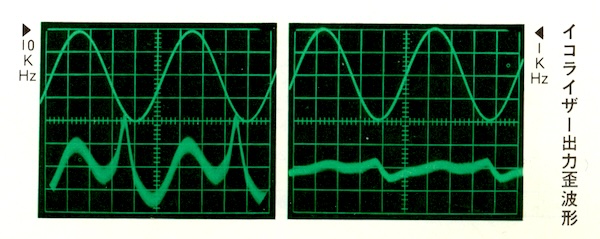
source: 季刊ステレオサウンド No.21 ’72 (Vo. 7, No. 2) 特別増刊 プリアンプ・パワーアンプのすべて (1972)
SONY TA-2000F プリアンプ内蔵フォノイコの 1kHz / 10kHz 出力歪
1kHz / 10kHz output distortions of SONY TA-2000F’s phono preamp
そして、各評論家による試聴テスト時にも、これらの計測結果も参照しながら総合評価されています。ここ数十年は主観的な官能評価が主流となってしまった印象のある日本のオーディオ評論の世界ですが、当時のステレオサウンド誌は、科学・工学的側面もきちんと重視していたことの表れなんだろうと感じ、胸の空く思いです。
The results of these measurements were also referred to during listening tests by audio critics for a comprehensive evaluation. I have the impression that subjective sensory evaluation has become the mainstream in the world of Japanese audio criticism over the past few decades, but I feel that this is a sign that Stereo Sound magazine at that time was also placing emphasis on the scientific and engineering aspects of audio criticism — making me feel refreshing.
| Domestic (Japanese) Models | on Page |
|---|---|
| Luxman CL35 | 208 |
| Pioneer QC-80 | 164 |
| Pioneer SC-70 | 156 |
| Pioneer SC-100 | 160 |
| SANSUI CA-606 | 102 |
| SONY TA-2000F | 114 |
| SONY TA-2244 | 128 |
| Technics SU-30A | 136 |
| Victor MCP-105 | 184 |
| Victor MCP-V9 | 192 |
| Victor PST-1000 | 188 |
| Imported Models | on Page |
| AMCRON IC-150 | 240 |
| CM Laboratories CC-1 | 244 |
| DYNACO PAS-3X | 270 |
| DYNACO PAT-4 | 266 |
| JBL SG-520E | 290 |
| Maranz Model 33 | 318 |
| McIntosh C-26 | 302 |
| McIntosh C-28 | 306 |
| Quad 33 | 340 |
| SAE Mark I | 332 |
さて、RIAA偏差の計測結果です。この雑誌が出版された1970年代前半、すなわち8割以上がソリッドステートアンプの時代にあっても、全てのアンプのRIAAフォノEQの特性(偏差)が、もう面白いようにバラバラです。
Now, here are the results of the RIAA deviation measurements. Even in the early 1970s, when this magazine issue was published, i.e. when more than 80% of amplifiers were already solid-state amplifiers, the RIAA phono EQ characteristics (deviation) of all amplifiers are interestingly different each other.
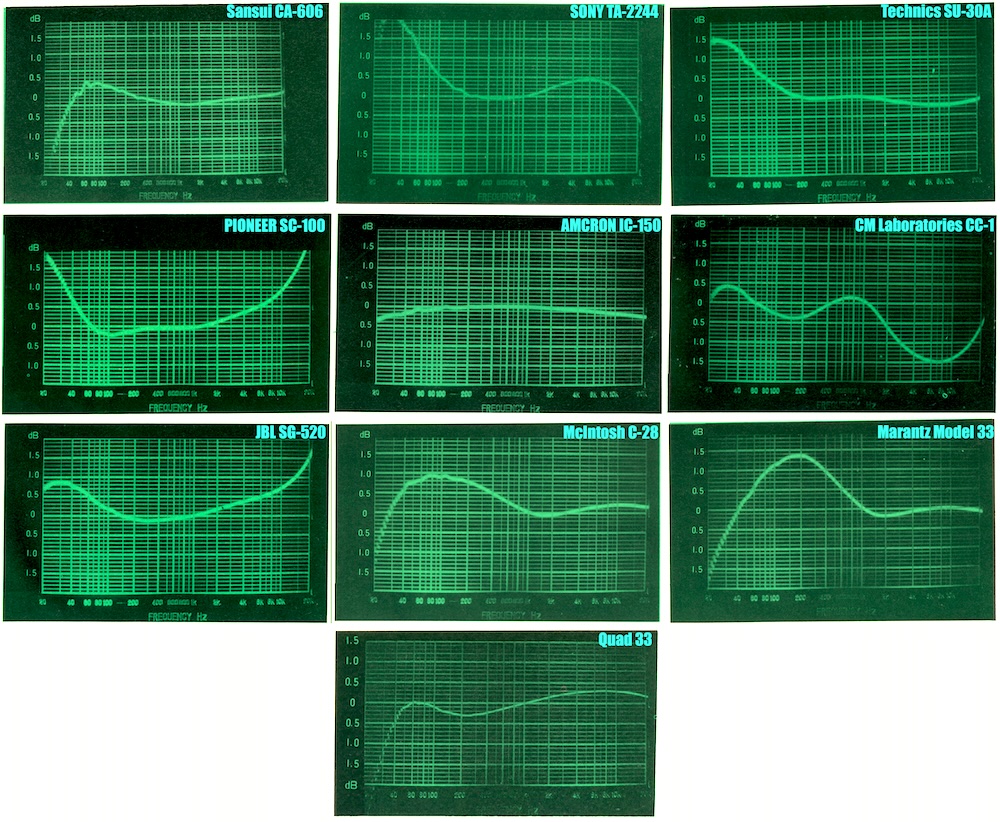
source: 季刊ステレオサウンド No.21 ’72 (Vo. 7, No. 2) 特別増刊 プリアンプ・パワーアンプのすべて (1972)
レビューされたプリアンプのRIAA偏差グラフの一例
定義域は20Hz〜100kHz
Some examples of RIAA deviation graphs (from 20Hz to 100kHz), measured by this particular magazine, of various preamplifiers.
技術とコストのバランスによる割り切りによる結果のものもあるでしょうし、中には「音作りの一環」として敢えて狙った特性にしたものもあるでしょう。
Some of these may be the result of a split in the balance between technology and cost, while some may be the result of the “part of the sound creation process”.
各アンプが想定しているカートリッジのインピーダンスやインダクタンスなども関わってくるので、計測手法(これは当該号の前号に詳細が載っているそうですが未確認です)の問題もあるかもしれませんが、それにしても面白いです。
The impedance and inductance of the cartridges that each amplifier was designed for are also involved, and there could be a problem with the measurement methods (which is detailed in the previous issue of the Stereo Sound magazine, but I have not yet confirmed this), but anyway it is interesting nontheless.
それだけ、「RIAA」という単一ポジションであっても、1970年代前半の民生用アンプにおいては、実装方針や実装方法も異なるし、周波数応答特性的にも違いが生じていた、ということなのかもしれません。いわんや1950年代〜1960年代の各種非RIAAポジションをや。
This may be why, even with a single “RIAA” position, consumer amplifiers in the early 1970s had different implementation policies and methods, as well as different frequency response characteristics. This would imply, of course, that the various non-RIAA positions in the amplifiers of various manufacturers in the 1950s and 1960s would also have had different characteristics each other.
周波数応答特性という静的特性が再生音の全てを決定するものではないのは当然のこととして、ともあれ、上の計測結果は非常に興味深いものであることは間違いありません。
While it is obvious that the static characteristics of frequency response alone do not determine the entire sound reproduction, the results of the above measurements are cirtainly very interesting.
23.2 “LCR” vs “RC” on phono equalization
民生用のアンプで、同じRIAAポジションであっても、特性のバラツキがあり得たことを学びましたが、ではプロフェッショナルの世界ではどうだったのでしょうか。
So far we learned that in consumer amplifiers, even with the same “RIAA” position, there could be variations in characteristics. So how was it in the professional field?
1930年代から放送局業界で広く使用されていたトランスクリプション盤においては、縦振動盤についてはベル研開発の1種類の録音再生特性しか存在しませんでしたし、録音・再生イコライザもベル研製のものが使われていました(Pt. 4 セクション 4.4 参照)。
For the transcription records widely used in the broadcast industry since the 1930s, there was only one type of recording/reproducing characteristics for vertical (hill-and-dale) records developed by Bell Labs, and the equalizers were also made by Bell Labs alone (see: Pt. 4 Section 4.4).
横振動トランスクリプション盤は、NBC/RCA が1939年に採用した “Orthacoustic” 録音再生特性が、1942年NAB規格として採用され、NBC/RCA 自社開発、または Westrex 製の録音・再生イコライザが広く普及していたため、ラジオ局業界では録音・再生特性が非常に統一され、使用されていたことになります(Pt. 5 セクション 5.2 および Pt. 9 セクション 9.3 参照)。
For the lateral transcription records, the “Orthacoustic” recording/reproducing characteristics adopted by NBC/RCA in 1939, later adopted as the NAB Standards in 1942. NBC/RCA’s own or Westrex EQs were widely used in the industry, which meant that the recording/reproducing characteristics were very uniform (see: Pt. 5 Section 5.2 and Pt. 9 Section 9.3).
この時に使われていたのは、LCR 録音・再生イコライザでした。つまり、抵抗、コンデンサ、コイル(インダクタ)の組み合わせにより、録音再生イコライザが構成されていました。パッシブイコライザの場合、挿入損失は15dB〜25dBほどありました。
For these professional boradcasting, LCR recording/reproducing equalizers were used, which consisted of: L = inductor, C = capacitance, and R = resistance. Insertion loss of passive LCR EQs were about 15dB to 25dB.
この LCR イコライザのうち、L、すなわちインダクタが製作精度によって特性のバラツキが出やすく、そのため歩留まりが悪く、最も高価なパーツです。ラジオ局のようなプロフェッショナル市場ではなく、民生用レコードの世界では、特に再生フォノイコライザが(ごく一部の例外的な製品を除いて)アクティブRC(CR型、NF型など)であるのは、制作難易度とコストの問題ということになります。
Of these LCR EQs, L (inductor) is the most expensive part, because it is prone to variations in characteristics due to manufacturing precision and therefore has the lowest yield. In the world of consumer records, rather than in the professional market like broadcast stations, the reason why playback phono EQs in particular are, with the exception of very few products, active RCs (including Capacitor-Resistor type and Negative-Feedback type) is a matter of production difficulty and cost.
1960年代末頃から現代に至るまで、民生用レコードカッティング機材でデファクトスタンダードとして使われているのは Neumann 製システムで、一部 Westrex や Ortofon もありますが、これらの録音イコライザも全て アクティブRC です(Pt. 19 セクション 19.2.8 およびそれ以降 参照)。
From the late 1960s to the present day, the de facto standard in consumer record cutting equipment has been Neumann systems, with some Westrex and Ortofon, but all of these recording equalizers are also active RCs (see: Pt. 19 Section 19.2.8 and following).
ところが、1960年代中盤までは、米国の民生用レコードのカッティング現場、特にメジャーレーベルや大手スタジオでは、主に Western Electric 社製のLCR録音イコライザが使われていました。
Until the mid-1960s, however, LCR recording equalizers manufactured by Western Electric were used primarily at U.S. consumer record cutting facilities, especially at major labels and major studios.
本記事の Pt. 0 〜 Pt. 3 を書いていた2022年秋頃、Nicholas Bergh さんとやりとりをした際、“LCR” vs “RC” イコライザの違いについて教えてもらったことがあります。以下、その時のメールのやり取りを元に整理したものです。
When I corresponded with Nicholas Bergh-san via emails in the fall of 2022, when I was writing Pt. 0 to Pt. 3 of this article, he taught me about the difference between “passive LCR” and “active LR” equalizers. Below is a summary based on that email exchange.
What was going on in broadcasting (especially in the 1930s and 1940s) was different than music studio recording.
(特に1930年代〜1940年代の)放送局においては、音楽スタジオのレコーディングとは事情が異なっていた。
With broadcast studios, playback equipment was professional and high quality. As a result, they could make perfect LCR playback eq that exactly matched the LCR recording eq. This is how these curves started.
放送スタジオでは、プロ仕様かつ高品質な再生機器が使用されていた。その結果、LCR 録音イコライザと正確に一致する完璧な LCR 再生イコライザが作られた。放送局における録音再生カーブはこのように始まった。
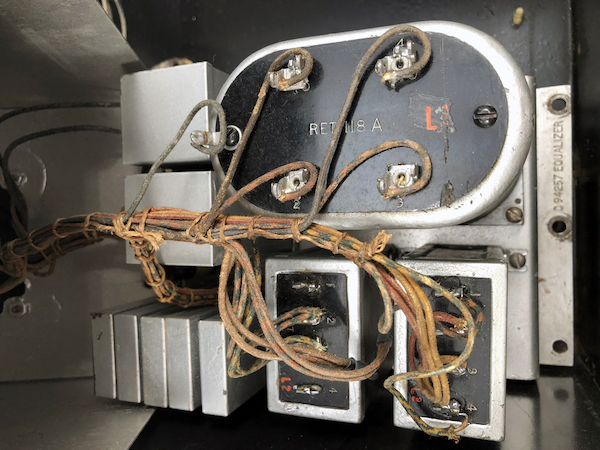
Very rare WE playback LRC compensator (equalizer) from early 1930s for WE vertical transcription disc
非常に珍しい1930年代前半製 Western Electric 社製、縦振動トランスクリプション盤再生用LRCフォノイコの実物 (Nicholas Bergh さん提供)
photo courtesy of Nicholas Bergh.
With music studio recording, on the other hand, the records were played back on cheap home equipment that varied widely, while major studios used LCR recording eq. Home playback equipment did not ever use LCR eq as far as I know. Only RC eq. So one can get into a philosophical discussion about what eq is correct today.
一方、音楽スタジオにおけるレコーディングでは、大手スタジオでは放送スタジオ同様にLCR録音イコライザが使われていたが、レコードはさまざまな種類の安価な家庭用機器で再生されるものだった。知り得る限り、当時の家庭用再生機器では LCR 再生イコライザが採用されたことはなく、RC 再生イコライザだけだったはずである。そのため、現在では「どのイコライザが正しいのか」について哲学的な議論になることがある。
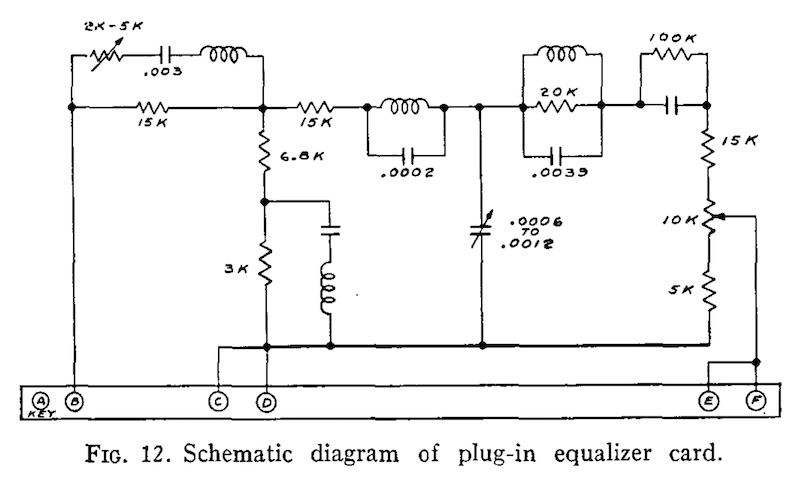
source: “The Westrex 3D StereoDisk System”, C.S. Nelson and J.W. Stafford, Journal of the Audio Engineering Society, Vol. 12, No. 3 (July 1964), pp.178-185.
This plug-in card (for Westrex 3D cutterhead) provides constant velocity equalization from 1kHz to 15kHz, and RIAA equalization from 30Hz to 1kHz.
RA-1574-D 用プラグインイコライザカードの回路図。
Westrex 3D カッターヘッドの記録特性を 1kHz 以下を RIAA 特性、1kHz 以上は等速度フラットに整えるもの。
People were almost certainly listening back with RC eq, even though the recordings were made with LCR eq.
LCR 録音イコライザで行われた録音であっても、当時の人々はほぼ間違いなく RC 再生イコライザで聴いていたことになる。
In the studio they were typically checking the discs with LCR eq, but producers and musicians would also take records home and listen to their RC home gear.
録音スタジオ内では、通常 LCR 再生イコライザでレコードをチェックしていたが、プロデューサやミュージシャンがレコードを自宅に持ち帰ると、RC 再生イコライザを内蔵した自宅の機器で聴いていたことになる。
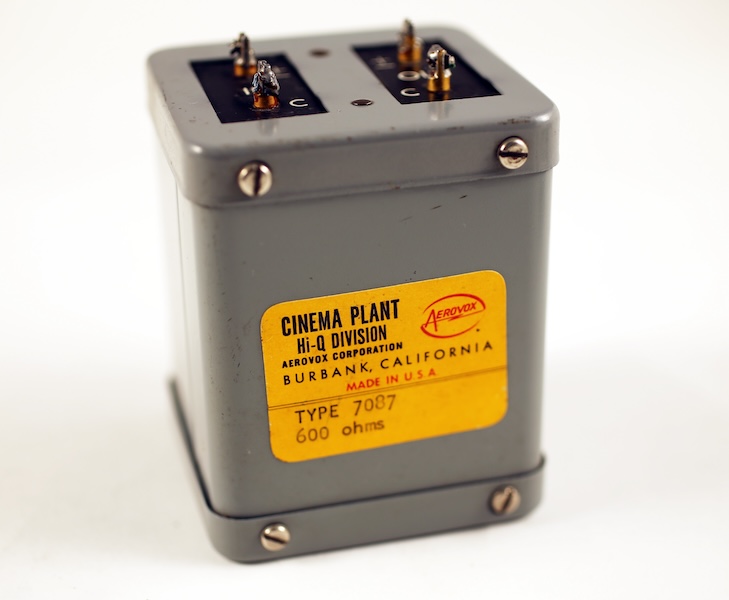
Cinema Engineering Type 7087 Passive LRC Playback Equalizer Unit
photo courtesy of Nicholas Bergh.
こちらは再生用パッシブLRCフォノEQユニット Type 7087 の貴重な実物写真。Nick さん提供。
One could say that most people would hear it as RC, but only LCR playback will have perfect phase response like modern RIAA with modern RIAA cutting (by RC eq).
ほとんどの人が LCR 録音イコライザでカッティングされたレコードを RC 再生イコライザで聴いてきたわけだが、LCR 再生イコライザでないと完璧な位相特性での再生とならない。一方、現代の RIAA 特性のレコードは、RC 録音イコライザでカッティングされているので、RC 再生イコライザで RIAA 再生を行うと完璧な位相特性での再生となる。
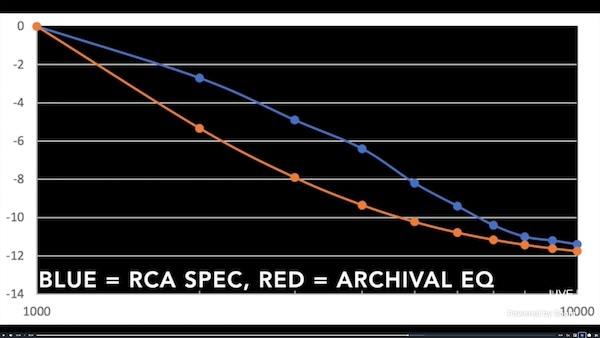
source: Online Presentation by Nicholas Bergh at the ARSC Conference 2022 (available only for ARSC members)
RCAオリジナルスペックの再生EQカーブと、現代的な可変フォノイコによるカーブとの差分と思われるグラフ
Nicholas Bergh さんによる ARSC Conference 2022 プレゼンスライドより
(プレゼンはARSC会員のみ閲覧可能)
Recording systems (such as Westrex’s recording amplifiers and their LCR recording equalizers) would have been used by RCA, Columbia, Capitol, etc. (presumably until mid-late 1960s).
Westrex 録音アンプとLCR録音イコライザといった当時を代表する録音システムは、RCA、Columbia、Capitol などで(1960年代中頃〜末頃まで)使われていたはずである。
To further complicate things, some studios in the 1950s and 1960s were using cutting systems with RC eq. Smaller studios in the US such Decca and Chess were using the Gotham/Grampian system shown on this link. This system sounds very different from the Westrex system.
さらに事態を複雑にしたのは、1950〜60年代当時であっても RC 録音イコライザによるカッティングシステムを使用するスタジオがあったことである。Decca や Chess といった米国の小規模スタジオでは、Gotham/Grampian システムを使っていたことが知られている。このシステムでカッティングされたものは、Westrex システムでカッティングされたものとは全く異なるサウンドとなる。
It was the Bell Labs / Western Electric legacy in the US that likely caused the continuation of LCR eq for a long time. They could get the exact curve they wanted with this approach.
米国で長い間 LCR イコライザが使われ続けたのは、おそらくは、ベル研究所と Western Electric の遺産があったからと考えられる。彼らはこのアプローチで狙い通りのカーブの実現を可能にしていた。
これに類する議論は、Nick さんが2022年5月の ARSC 会議(オンライン開催)で発表された「Understanding Errors in Archival Phono EQ Standards by Looking at Original Disc Recording Equipment」でも詳しく触れられています。
Similar discussions are covered in detail in Nick-san’s online presentation at the May 2022 ARSC Conference, entitled “Understanding Errors in Archival Phono EQ Standards by Looking at Original Disc Recording Equipment”.
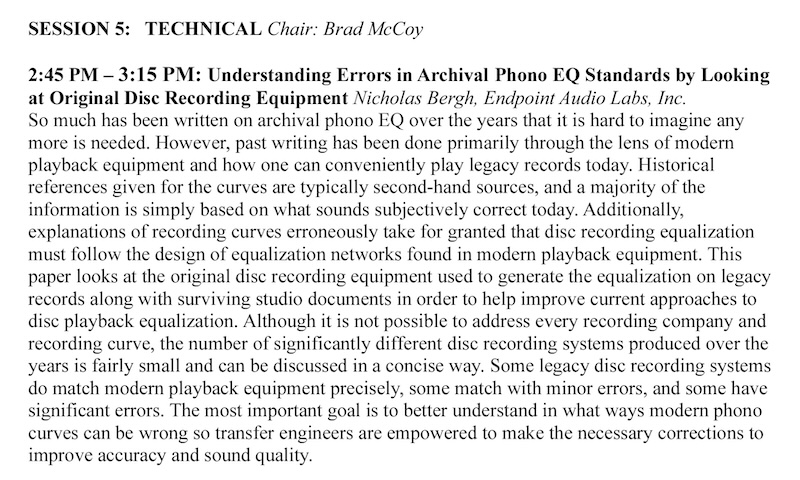
source: ARSC 2022 (56th Annual Conference & Workshops, May 17-21, 2022) Program.
Nick さんが ARSC 会議で発表したプレゼンのアブストラクト
私の理解の範囲内では、Nick さんの論旨は、「過去のさまざまなレコードのカッティング時に使われていた録音イコライザの構成は、現代的な可変フォノイコで実装されている構成とは大きく異なり、必ずしもターンオーバー/ロールオフ/ベースシェルフの値のみで完全に合致するものではない」、そして「古いレコードのより正確な再生を目指すためには、当時の一次資料に立ち戻り、当時の録音イコライザの回路図を検証し、それに近い補正を行うイコライザを制作する必要がある」という辺りに集約されると思っています。
As far as I understand it, I believe Nick-san’s argument can be summarized as follows: “The recording equalizer configurations used when cutting various records in the past were very different from the configurations implemented in modern archival phono equalizers, and both do not always match perfectly simply based on turnover/rolloff/bass shelf values alone”, and “In order to achieve more accurate reproduction of old records, we need to go back to the primary source materials of the time, verifying the recording equalizer schematics of the time, and producer an equalizer that provides a correction very close to that of the original”.
「XXXレーベルのカタログ番号YYYのレコードは、RIAA か AES か Columbia LP か、どれで再生するのが最も望ましいか?」という議論以前に、そもそも LCR / RC イコライザの違いを含めた回路構成の違いもあるよね、ということになるのでしょう。
Before the discussion of “which is most desirable to play a record with catalog number YYY from the XXX label, RIAA, AES or Columbia LP?”, we must be noted that there are differences in circuit configuration, including differences in LCR / RC equalizers.
すなわち、現代の可変カーブ対応フォノイコライザは、そのほとんどが RC イコライザでしょうが、どんなに正確にカーブが一致しているようであっても、LCR 録音イコライザを使ってカッティングされたレコードは、厳密には、位相特性の点で100%正確な再生とは言えない、ということになります。
In other words, most of the modern “archival” phono equalizers that support variable curves are RC equalizers, but no matter how accurately the curves seem to match, records ut with LCR recording equalizers are not, strictly speaking, 100% accurate reproduction in terms of phase response.
職業アーカイバや学術研究者はさておき、趣味の音楽ファンやオーディオ愛好家が、果たしてそこまで厳密にこだわることができるのか、あるいはこだわる意味があるのか、非常に難しい領域だとは思います。
Aside from professional archivists and academic researchers, I think it is a very difficult question whether it is really possible for hobbyist music fans and audiophiles to be so rigorous about it, or if it is even worth being so rigorously particular.
「録音・再生イコライザ」の問題は、かように一筋縄ではいかない、歴史的経緯や技術的背景が絡まり合った問題である、ということが分かります。これらを学び理解し続けた上で、「おおよそこんな感じが近い」「主観的に好ましく聴こえると感じる」という意見であればよいのですが。
The issue of “recording / reproducing equalization” is not a simple one, but one that is intertwined with historical and technological backgrounds. I do hope I/you/we have learned and understood all of these never-ending things, and that the opinion is “approximately close to this” or “I feel it sounds subjectively favorable”.
23.3 The summary of what I got this time / 自分なりのまとめ
Pt.0 公開から1年9ヶ月、まだ完結していません。そろそろまとめに入らねばと思っているのですが、知らないこと、知りたいことが次々と見つかってしまい、もはや本来の執筆の動機すらどうでもよくなってきました(笑)
It’s been over one year and nine months since I initially published Pt.0, and the entire article is not yet complete. I think it’s about time to start putting it all together, to summarize what I have learned. However, I keep finding things I don’t know, things I want to know, and even my initial motivation to start writing is no longer important…
ともあれ、前回 Pt. 22 で、1957年〜1964年頃に米国で販売されていた各種オーディオコンポーネントの仕様を調べることで、当時のオーディオマニアの方々が使用していたであろうアンプにおけるフォノEQポジションの変遷を知ることができました。
Anyway, in the previous Pt. 22, I was able to learn about the changes and trends in phono EQ positions in amplifiers that audiophiles of the time would have used, by examining the specifications of various audio components sold in the U.S. between 1957 and 1964.
もちろん、レコード購買者のうち過半数…どころか大多数を占めていた一般リスナーは、セラミックカートリッジ付ポータブル電蓄や家庭用ステレオセットでレコードを聴いていたわけで、そもそもフォノEQカーブなんて気にせず聴いていたわけですよね。それが当時の大多数のレコード購買層にとっての景色だったわけで。
Of course, the vast majority of record buyers a.k.a. “ordinary listeners” were listening to records on portable phonographs or home stereo sets, both with ceramic cartridges. They did not even care about phono EQ curves in the first place. This would be the view of the majority of record buyers at that time.
さてさて、今回の内容をざっくりまとめると、こんな感じでしょうか。
…so, the rough summary of my understanding in this Pt.22 article would be something like this:
1972年に発行された日本のオーディオ雑誌の特集に、当時の国内外のプリアンプの内蔵フォノイコライザ全21機種の特性計測結果が掲載されているが、各メーカ、各機種ごとに RIAA 偏差のばらつきが非常に大きく、全て RIAA 準拠と謳ってはいるものの、その実装方法や補正特性がバラバラであったことを確認した。
In a Japanese audio magazine published in 1972, there was a special feature on 21 preamplifiers available at that time, in which the characteristic measurement results of the built-in phono EQs of each model were published. Although all of them claim to be RIAA-compliant, I confirmed that their implementations and compensation characteristics were so different each other.
放送局など米国プロフェッショナル機器においては、伝統的にベル研やWestrexのレガシーの享受を受けてきたが、この際、ディスク録音イコライザ(やプロフェッショナル用再生イコライザ)はLCR回路で構成されていた。一方、民生用のオーディオ装置においては、インダクタに伴うコストの問題や品質の均一性の問題から、RC回路によるフォノイコがほとんどである。
In U.S. professional field, such as broadcasting stations, they had traditionally enjoyed the legacy of Bell Labs and Westrex, in which disc recording equalizers (and professional playback equalizers) were constructed with LCR circuits. On the other hand, in the consumer audio market, most amplifiers had built-in phono EQs with RC circuits, highly presumably due to cost issues associated with inductors and quality uniformity.
1920年代〜の歴史的録音・映像の復刻や、当時の録音再生機器のプロフェッショナルである Nicholas Bergh 氏は、現代の「アーカイブ用可変フォノイコライザ」はRC型であり、レコードが録音された当時のLCR型録音イコライザとは厳密に対応できない点を、学会発表で指摘している。
Nicholas Bergh, a professional in the reissue of historical recordings and videos from the 1960s onward, and a professional in the field of recording/reproducing equipment of the time, pointed out in his conference presentation that, modern “archival” variable phono EQs are of the RC type, and do not exactly correspond to the LCR type recording equalizers of the time the records were made.
次回こそは、そろそろ今までのまとめに入れたらと思っていますが、果たしてどうなりますやら… もうしばらくお付き合いください。
In the next Part 24, I really hope that I will be able to put together a summary of what I have learned and studied so far, but we’ll see what happens… Please stay with me for a little while.
» 続き / Sequel: “Things I learned on Phono EQ curves, Pt.24” »
